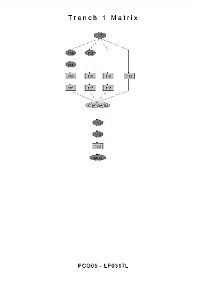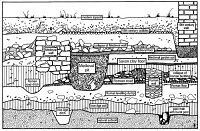Stratigraphy is the fundamental concept of the process of excavation and understanding archaeology. Layers of soil or other materials are deposited in the past in chronological order, with the oldest layer at the bottom.
The principals of stratigraphy are used to demonstrate the relationships between different actions in the past that are revealed during excavation. It is rare for archaeological sites to have strictly divided horizontal layers of archaeological deposits. Later activities may cut through earlier deposits – so the construction of the basements on Prescot Street during the Victorian period cut through earlier deposits, and were at a lower level than older surrounding deposits. Great care needs to be taken when excavating to identify these cuts to ensure that finds from them are not mixed up with earlier surrounding material.

A Harris matrix from the 2006 Prescot Street evaluation, demonstrating the relationship between different contexts.
During excavation, complex changes of texture, colour and content of layers are observed. These are recorded horizontally in plans and vertically in sections. By detecting cuts and fills, and when soil was removed or redeposited, we can tell the order in which the layers were created – this is called the ‘sequence’. The sequence helps archaeologists to understand these actions in the correct order they occurred in during the past on any particular site.
Archaeologists use the Harris Matrix (right) as a method of recording these relationships and presenting them as easily understood diagrams.
- By: Lorna Richardson |
- Mar 06, 2008
- Share
